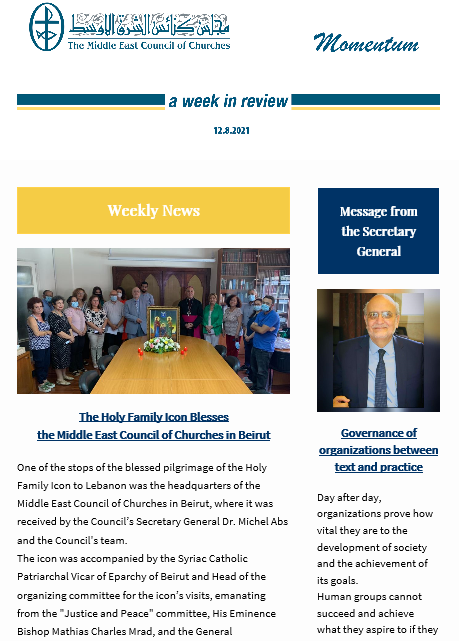Momentum, the Weekly Newsletter from the Middle East Council of Churches
This news is also available in Arabic.
The new issue of the weekly newsletter Momentum prepared by the Communication and Public Relations Department of the Middle East Council of Churches, presents interviews and articles published in the special issue of "Al Muntada" magazine, issued on the first commemoration of the Beirut port explosion. You can find two exclusive interviews with HE Bishop Elias Audi and HE Archbishop Boulos Abdel Sater, about the Beirut blast disaster and the Church’s role in facing its repercussions and helping its affected people. As for the weekly message of the Secretary General Dr. Michel Abs, it was entitled "Governance of organizations between text and practice".
It also Includes the introduction of the special issue of the MECC quarterly magazine “Al Muntada” written by the Editor in Chief, Director of the Communication and Public Relations Department Huguette Salameh, and entitled “Beirut, in the Heart of the Church, Beirut, a City of Resurrection”. As well as, a two-part booklet prepared by the Communication and Public Relations team including the MECC activities, reports and interviews that covered weekly news, information and updates about the blast and its judicial investigations, during a year since the explosion.
In addition to an article written by the journalist Melvine Khoury, survivor of the disaster, and an investigation article about St. Anthony the Great church in Gemmayzeh, which was severely damaged along with its parish.
The issue also includes MECC Departments’ news such as the visit of the Holy Family Icon to the MECC headquarters in Beirut, various Ecumenical reports, videos related to the Council, weekly Prayer, and news of the Middle Eastern Churches.
The issue also includes a socio-economic overview on the Middle East, Coronavirus in the region updates, and developments related to the Beirut Port Blast.

